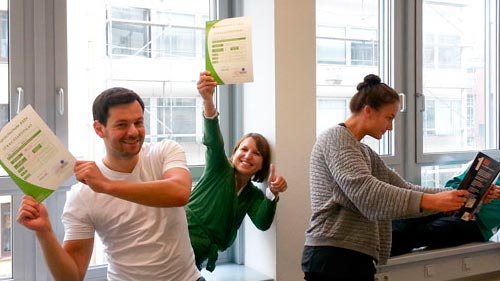“Es gibt”, “da ist”, “da sind”? – Definition, Explanation in English
When it comes to learning German, there are many grammatical rules and structures that make little sense to foreign eyes and ears. The idea of umlauts, capitalized nouns, and article endings can be intimidating for beginners. However, that does not mean that it is impossible! Below we will take a peek into useful phrases and common grammatical structures that are essential to beginners. What about “Es gibt”, “da ist”, and “da sind”? There, there, there – Its Definition and Explanation in English
So, what is the difference between “es gibt”, “da ist”, and “da sind”?
Although all three mean there is, they are used in certain circumstances!
Es gibt (+Accusative)
Accusative Articles Review
| Accusative Definite Articles
(The) |
|||
| Masculine | Feminine | Neutral | Plural |
| Den | Die | Das | Die |
| Accusative Indefinite Articles
(A/An) |
|||
| Masculine | Feminine | Neutral | Plural |
| einen | eine | ein | xxx |
When using “es gibt”, means that there is someone (or many people) or something (or many things) that exists or belong all together. It is a more general way of saying that something or someone exists.
- Unlike in English, there is no plural form of “es gibt”. You would never say es geben. It does not matter how many things or people you are talking about, it is always in the third person, singular form.
- Helpful tip: Think about when speaking about your family. Although you are speaking about multiple people, you would still say “My family is doing well”.
- In this case, “Es” is the subject, making the next noun the object of the sentence and causing the object to be in the accusative case.
Examples:
- Es gibt keine Vampire -> There are no vampires.
- Why es gibt? Because Vampires do not exist
- Es gibt einen Apfel auf dem Tisch -> There is an apple on the table.
- Why es gibt? Because the apple exists and is on the table.
- Diese Schuhe gibt es in rot, blau und grün.->There are shoes in red, blue, and green.
- Why es gibt? Because the shoes exist and are available in red, blue, and green.
Da ist/ Da sind (+Nominative)
Nominative Case Review:
| Nominative Definite Articles
(The) |
|||
| Masculine | Feminine | Neutral | Plural |
| Der | Die | Das | Die |
| Nominative Indefinite Articles
(A/An) |
|||
| Masculine | Feminine | Neutral | Plural |
| Ein | Eine | Ein | xxx |
“Da ist” and “Da sind” are used in situation when speaking about or showing an exact thing(s), person, or people.
Things to note:
- This is useful when presenting someone something or someone new.
- Like showing someone an unfamiliar building, a new car, or directions
- This can also be used in surprising situations
- It says in the nominative case because what is being shown or spoken about is the subject of the sentence.
- “Da ist” is used when talking about singular subject and “Da sind” is used when talking about multiple things.
Examples:
- Das ist ein Brief für dich auf dem Tisch. -> There is a letter for you on the table
- Why das ist? It is speaking about one specific letter.
- Das ist das Weiß Haus. -> That is the White House.
- Why das ist? It is speaking about a specific house.
- Da sind die Karotten in der plastic Tüte. -> There are the carrots in the plastic bag.
- Why das sind? It is speaking about the specific carrots that are in the bag.
- Schau, da sind Blumen im Gras! -> Look, there are flowers in the grass.
- Why das sind? It is speaking about the specific flowers that are in the garden. This is also an example of a surprise.
- Ich spiele in einem Fußballverein mit einem internationalen Team. Da sind auch Engländer und Franzosen. -> I play in a soccer club with an international team. There are also Englishmen and Frenchmen.
- Why da sind? It is speaking about a specific Englishmen and Frenchmen on soccer team.
What else is there to say?
When speaking out in the real German world, there are common colloquial phrase that are used. Check some of them out!
- ‘Was gibt’s?’
This is a greeting and a start to a casual conversation. The English equivalent is, “What’s up?”
- ‘Was gibt’s Neues?’
This is another casual greeting and start to a conversation. The English equivalent is, “What’s new?”
- ‘Was gibt’s (zu essen)?’
This is something that would be casually said before eating a meal. This is the English equivalent of “What is there to eat?”
- ‘Das gibt’s doch nicht!’
This would be used as a surprised, negative reaction. It is used when you cannot believe something. The English equivalent is “I can’t believe it!”
In German, you could also say ‘Ich glaub’s nicht!’
- ‘Gibt es eigentilich Vampire?’
This question is asking, “do vampires actually exist?” Like any other question in German or English, the verb is place first following the subject.
Well, quickly said…
‘Das ist/ Das sind’ is used when presenting or point out a specific place or thing. ‘Es gibt’ is used when introducing a new unspecific, general topic or thing.
